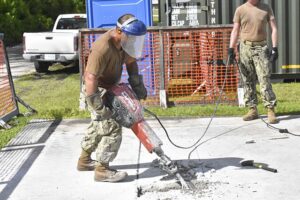Knowing how to demolish concrete properly before starting is essential because it is one of the most durable materials you’ll ever deal with around your home.

Whether you’re removing an old patio, breaking up a cracked driveway, or redoing a walkway, demolishing concrete isn’t as simple as swinging a sledgehammer. However, with the right tools, approach, and safety precautions, many homeowners can tackle smaller jobs on their own—provided they know their limits.
Here’s a practical guide to help you safely demolish concrete at home—and to know when it’s time to bring in the professionals.
What You’ll Need
Before you start swinging, make sure you’ve got the right tools and safety gear. At a minimum, you’ll need:
-
Safety gear: Eye protection, hearing protection, gloves, steel-toed boots, long sleeves, and a dust mask.
-
Tools:
-
Sledgehammer (8–20 lbs): Best for breaking up thinner slabs (4 inches or less).
-
Pry bar or mattock: To lift and move broken chunks.
-
Wheelbarrow or dumpster: For hauling debris.
-
Jackhammer or demolition hammer (rentable): For thicker slabs or reinforced concrete.
-
Reciprocating saw with metal blade: If dealing with rebar.
-
Concrete saw or angle grinder: For clean edges or control joints.
-
Step-by-Step: How To Demolish Concrete Yourself
1. Assess the Thickness
Measure the slab’s depth. If it’s 4 inches or less, you may be able to do it with just a sledgehammer. Thicker slabs or reinforced concrete (with rebar) usually require power tools or professional help.
2. Check for Utilities
Always check Line search Before you dig to search for underground utilities before digging or demolishing. Damaging a gas or water line can be catastrophic—and extremely expensive.
3. Start at the Edge
Begin striking near the edge or a crack, where the concrete is weakest. Use short, controlled swings and let the hammer do the work. Working the weaker spots will save your back in the long run, especially if there’s a large amount of concrete to remove.
4. Create Cracks
Work in small sections. Breaking up one area helps relieve tension and weakens nearby sections. If you’re using a jackhammer, go straight down and wiggle the bit to widen the break.
5. Lift and Remove
Use your pry bar or mattock to lift and remove chunks. For heavy pieces, a wheelbarrow with solid tires is your best friend. If you don’t have a wheelbarrow, you can potentially use plastic bins but transfer the concrete in smaller portions.
6. Dispose Properly
Concrete debris is heavy and may require a special dumpster or trip to a local landfill that accepts construction material. Call ahead to confirm rules. This is potentially one of the biggest pitfalls to do it you
When It’s NOT a DIY Job
Sometimes, breaking concrete isn’t just tough—it’s dangerous. Here’s when you should step back and hire a professional:
🚫 It’s Reinforced with Rebar or Wire Mesh
Breaking rebar-laced concrete requires special tools and experience to avoid injury or structural damage.
🚫 It’s More Than 6 Inches Thick
Thick concrete slabs (like driveways or foundations) need high-powered tools like skid steers or hydraulic breakers.
🚫 There Are Nearby Structures
If the slab is near your home’s foundation, plumbing, or retaining walls, you risk causing major structural issues.
🚫 Dust and Noise Ordinances Apply
Demolishing concrete is LOUD and dusty. In dense neighborhoods or areas with strict regulations, a licensed contractor can handle permits and mitigate risks.
🚫 You’re Not Physically Able
Concrete work is labor-intensive. If you have back issues or limited mobility, the job might be unsafe for you to tackle alone.
Hiring a Pro: What to Expect
When you hire a contractor for concrete demolition, they’ll usually provide:
-
A fixed quote based on volume and complexity
-
Proper disposal and recycling of materials
-
Heavy equipment for fast removal
-
Insurance coverage in case something goes wrong
Always verify licensing, insurance, and references before hiring.
Final Thoughts
Demolishing concrete can be satisfying and cost-effective—if the job is manageable. For small slabs and patio removal, a determined homeowner can make real progress with the right tools and preparation. But if you run into thick concrete, rebar, or nearby infrastructure, don’t gamble with your safety or your home—call a professional.
Know your limits, plan carefully, and when in doubt, let the pros handle the heavy lifting.
